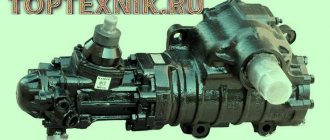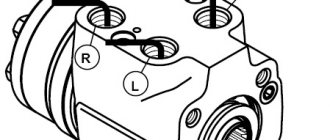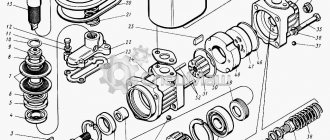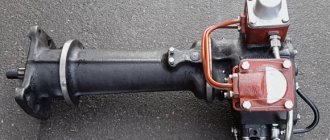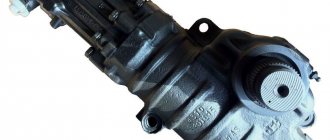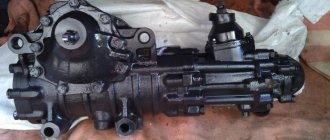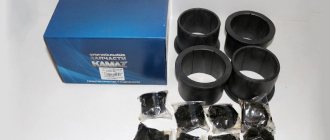Category: KAMAZ
- Purpose of the hydraulic power steering
- KamAZ power steering device
- Power steering pump
- Principle of operation
- KamAZ power steering malfunctions
- Pumping the KamAZ hydraulic booster
It’s hard to imagine how the truck would handle if it weren’t for the KamAZ power steering system. The operation of the parts and mechanisms of this device has become familiar to a heavy unit. The unit helps the user apply minimal force to turn the steering wheel. In addition, a number of complex functions are performed that affect the safety of the machine.
Each mechanism is subject to wear and tear, which will lead to loss of performance. Hydraulic power steering is no exception; the condition of the unit affects other components of the engine. That is why timely maintenance is important to maintain the performance of the amplifier.
The weak link in the steering is the hydraulics. The entry of air bubbles into the channels of the mechanism can stall the work and create an emergency situation. In order to respond to an emergency situation in a timely manner, an experienced user knows how to upgrade the power steering on a KamAZ and restore functionality.
KamAZ-5350:
Purpose
The main function of the mechanism is to reduce the force required to turn the steering wheel while the truck is moving. That is, the unit provides comfortable control and turning. If the system is faulty, even at low speed you have to exert significant effort, and at high speed, especially when performing maneuvers, control may be completely impossible (even to the point where the steering wheel jams).
Problems that the power steering solves
The main task of any power steering is to make it easier to turn the steering wheel. Without it, even minor turns of the steering wheel would require significant physical effort.
Another task of the KamAZ power steering is to guarantee normal vehicle controllability. In other words, this is an element necessary to ensure a sufficient level of safety during operation of the machine.
Feasibility of application
The main purpose of using power steering is to reduce the pressure created on the steering wheel of the car. Thanks to the effect, it is easier for the user to drive a car, and as a result, fatigue does not occur so quickly. It is also important that in the event of an emergency or force majeure situation, the driver will respond to changes more easily and quickly by adjusting the vehicle’s behavior and performing a maneuver.
In addition, power steering is involved in passive safety. Thus, an increase in speed is accompanied by an increase in resistance on the control wheel. This makes it possible to maintain a given trajectory without deviating from the course (which is fraught with an emergency). Breakage of the product does not lead to a complete loss of control; this once again indicates the safety of the unit. Premature worries are not appropriate, since failure is rare, but the joint operation of the amplifier and the car will bring a lot of positive aspects.
Amplifier KamAZ (Article 4310-3400020-03):
Device
The KamAZ power steering includes the following components:
- Distribution mechanism. It is used to direct flows of working media, including hydraulic oil, into the components and compartments of the power steering system.
- Hydraulic cylinder. Used as a converter of hydraulic pressure into mechanical impulses necessary for the movement of pistons and rods.
- Hydraulic fluid. This is the working medium that transmits force from the pumping unit to the hydraulic cylinder. The liquid lubricates the contacting elements and components.
- KamAZ power steering pump. Maintains the pressure required for correct operation of the system. The KamAZ power steering pump also circulates the working fluid.
- Elements for connecting nodes or highways. Necessary for combining all parts of the system into a single mechanism.
- Filter mechanism.
- Control device or electronic module. Used to guide and adjust work.
The KamAZ power steering device may differ slightly for different models of the Kama Automobile Plant.
Leveling up
There should be no air inside the working system. Removing it is called pumping. The general mechanization of power steering can be determined by the presence of the following systems:
- The power steering mechanism itself.
- To the right outgoing longitudinal thrust.
- Bipod.
- Oil radiator.
- High and low oil pressure pipelines.
- The pump adjacent to the expansion tank.
The main operating condition is the tightness of the system. If air appears, even a small air mass can get into almost any component, blocking its operation. Why is the seal broken? As a rule, air stagnation provokes a rupture of the oil pipeline, replacement of the pump, or any other repair that violates the tightness.
Characteristics of power steering
Design parameters:
- Steering mechanism - has a hydraulic booster installed in the same housing as the steering mechanism. The device includes a screw with a nut on rotating shafts and a piston that comes into contact with the toothed part of the bipod shaft.
- Gear ratio – 20
- The control valve is a spool valve, made with safety and bypass valves.
- The pump is a rotary mechanism with blades and a gear drive, gear ratio 1.25.
- The steering and hydraulic power steering are driven by a cardan shaft connected by a sliding spline; the angular gear is equipped with bevel gears.
- The radiator is an aluminum structure with fins installed in front of the radiator of the cooling system.
- Steering drive - has two rods (transverse and longitudinal types) with ball joints without the possibility of adjustment.
You can see the general diagram of KamAZ power steering in the picture at the beginning of the section.
Power steering repair
Repair of KamAZ power steering should be carried out by specialists with the necessary skills. It is best to order the service at specialized car services that service KamAZ vehicles or trucks.
Common faults
In general, repair of the hydraulic power steering on KamAZ trucks is required very often, since it is a fairly reliable system. Especially if the rules for using the node are followed and its scheduled maintenance is performed.
Typically, interruptions in power steering operation occur at sub-zero air temperatures, in winter, and during temperature changes. All failures of the KamAZ power steering can be divided into two categories: mechanical and hydraulic (both types of failures can occur in any part of the unit).
The main problem is related to the pump on KamAZ power steering: the viscosity of lubricants increases, which contributes to the squeezing out of oil seals and oil leakage. This malfunction especially often appears on cars that are operated incorrectly, for example, left in a parking lot with the wheels turned out. When starting the engine, the pressure increases only on one side, and the oil seal is squeezed out.
At positive temperatures, interruptions in the operation of the mechanism occur due to dirt and dust that are blown into the system. This leads to depressurization of individual elements, which increases wear on bushings and rods. Rust forms on the latter quite quickly, which also contributes to the rapid wear of the bushings. When using a truck, after 200-300 km, play appears between these parts, which causes a knocking sound from the steering rack. Gear adjustment is also often required.
Important: restoration and repair of KamAZ power steering should be carried out only by professionals, using specialized equipment.
How to remove an air lock from the system
When refilling with lubricants or after repairs, it is necessary to remove air from the system (bleed the power steering on a KamAZ).
The sequence of actions is as follows:
- Hanging the front axle so that the wheels do not touch the ground. The truck is lifted with a jack and trestles are placed under the beam on both sides.
You cannot start bleeding KamAZ power steering if the wheels are on the ground. Alternatively, you can disconnect the longitudinal link from the hydraulic booster.
- Removing the cap of the tank neck through which oil is poured.
- Removing the rubber pad from the bypass valve and fixing the elastic hose to the spherical head. The other end is located in a glass vessel with a volume of 0.5 liters, half filled with oil.
- Unscrewing the bypass valve half to three-quarters of a turn.
- Turn the steering wheel to the left until it stops.
- Fill the pump tank with lubricant to a level where it will not drop.
- Starting the engine and adding oil while rotating the crankshaft at low speeds. It is necessary that the oil level does not decrease until air bubbles stop forming at the outlet of the hose located on the bypass valve.
- Next, you need to close the bypass valve.
- Turn the steering wheel to the right all the way and back, to the left all the way. The steering wheel is held in this position, and the bypass valve is turned half to three-quarters of a turn. Here you also need to control the release of air bubbles. After the air has escaped, the bypass valve closes.
- Repeat step 9 several times. It is important to ensure that clean oil (without air impurities) ultimately comes out of the valve.
- Stopping the motor.
- Dismantling the hose and fixing the protective cap on the valve head. Then the lubricant level in the pump tank is checked. If the tie rod was disconnected, you need to reinstall it.
It is better if this work is carried out by specialists who know how to bleed the power steering on a KamAZ correctly so that there is absolutely no air left in the system.
Replacing parts when repairing power steering
When starting repairs of the hydraulic booster, power steering pump housing and other elements of the system, you need to understand that parts that have exhausted their service life cannot be restored, they can only be replaced with new ones. The production of spare parts with high precision and smooth surfaces is possible only in factories that specialize in the creation of such parts. That is why it is necessary to buy components for KamAZ from reliable companies that supply from official manufacturers.
Adjusting the steering gear
The steering mechanism can only be checked and adjusted in the position when the engine is turned off and the longitudinal steering rod is disconnected.
Before starting work, you need to check the wheel balancing, pressure level, presence of oil in the steering and hubs, settings of wheel bearings and rods, functioning of shock absorbers, quality of installation of the front wheels, oil level in the pump.
To check the force of the steering column, a dynamometer mounted on the wheel rim is used. The force is checked at different positions of the steering wheel: when turning 2 or more turns from the initial position, when turning three-quarters of a turn, when the wheel passes the initial position.
Forces that do not correspond to the specified values in the required positions must be adjusted. This may require dismantling the unit, its partial or complete disassembly:
- First, the adjustment is made in the third position, the adjustment is carried out using the bipod shaft screw;
- Then the first position is adjusted - you need to tighten or loosen the mounting location of the thrust bearings (partial disassembly of the mechanism is required);
- Adjustment in the second position is carried out with complete disassembly of the hydraulic booster.
Principle of operation
By turning the wheels of KamAZ-5410 and others, the rotor blades perform rotational movements and are adjacent to the stator. The parts that coincide with each other form passages into which lubricant is supplied and passes further due to the resulting pressure. The formed pressure pushes the liquid through the lower valve due to the fact that the oil, at the moment the passages of the distribution disk and the surface coincide, goes beyond the products.
Power steering pump KamAZ-65116, etc.:
The oil enters the rotor blades, having previously passed through the distribution disk. Due to the pressure, the blades adhere more strongly to the stator. The inlet and injection of liquid occurs simultaneously in two directions. An increase in rotor speed prevents the passage of lubricant through a calibrated hole from the area located behind the disk. The resulting pressure acts on the bypass valve, forcing it to open. As a result of valve activation, part of the working fluid passes through the manifold and again enters the suction surface.
